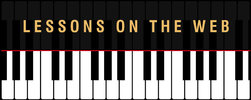|
Rhythm is basically its own language and has many different parts to it that we need to learn as pianists. One thing that you will find that is common in music as you continue to play, is patterns of notes, phrasing, and…rhythm. When we learn to recognize rhythmic patterns we will be able to play them without even thinking about it and reading piano music will be much easier. Before we continue, make sure you know what note durations are and how to count them. I give you a link in the video of where you can get extra help with this if you need any.
The first rhythm pattern we’re going to learn is the dotted quarter note followed by an 8th note.
It is common to have notes with different durations in the same beat and measure. What we’re doing here today is learning how to find the fastest way to count them and thus learn/memorize them. Subdividing larger beats into smaller beats, such as breaking a quarter note into two 8th notes, makes it much easier to feel the pulses at the correct time in correspondence to the correct notes. We can subdivide any beat, not just quarter beats. The next rhythm pattern includes 8th and 16th notes together. Now you might wonder, well which one am I supposed to subdivide…the 8th notes or the 16th notes.
Now, we can count our 8th note and 16th notes together by subdividing the 8ths into 16th beats…so we’ll count “1 e”, under the 8th note, and “& a”, under each of the two 16th notes. See how we placed the subdivided 16th beats with the 8th note to make it easier to match with the 16th notes? You can have any combination of 8th notes and 16th notes together and count them by simply subdividing the 8th beats into 16th beats and apply two 16th beats to each 8th note, and one to each 16th note. One more important thing to remember is that when you see a black straight line that goes over several notes together, then that means that all of those notes make up that one beat. When you learn how to subdivide all of your beats counting will be a breeze and these common rhythm patterns and the ones I’m going to show you in the following video will be really easy to recognize and play in your piano music. This video will take you to the keyboard and we’ll look at these rhythmic patterns written down as notes and I’ll write in the syllables we talked about here so you can make sure that you are getting that part correct. We’ll also go over lots of examples of subdividing different measure of varied rhythmic patterns to give you some good practice before you start trying it on your own. If you like my tips and lessons, you will love the courses over on my website. Whether you are a beginner looking to get a solid foundation to build on or you are looking to take you existing skills to that next level, the online music courses on my website https://www.pianolessonsontheweb.com will help you do just that.
|
AuthorMost blogs written by Archives
June 2020
Categories
All
|

 RSS Feed
RSS Feed